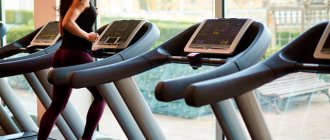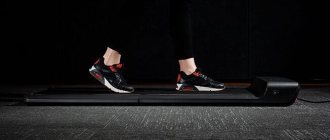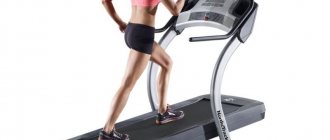- How many calories can you burn on the treadmill?
- About the technique of performing exercises
- When and how much to exercise
- What should your heart rate be for your body to start the fat burning process?
- How long should the workout last?
- Exercise options
- Examples of ready-made training programs
When purchasing a treadmill, many users hope that exercising on this machine will help them lose weight. However, few people realize: it is not enough just to get a simulator. You also need to properly create a training program for yourself on the treadmill. What should a running plan include for those planning to lose weight? What exercises can you do on a treadmill? What rules should you follow so as not to harm your body? Read about all this and more in our article!
How many calories can you burn while running on a treadmill?
Let's start with some motivating information, namely how many calories you'll burn during your workout. For an hour of exercise on a treadmill, the average person spends 400-500 kcal. This figure is approximate. Much depends on the intensity of the activity, the weight of the athlete and his physical fitness.
It is impossible not to mention other beneficial properties of walking and running. These types of aerobic exercise are recommended for developing endurance and improving blood circulation. Exercising on a treadmill allows you to “pump up” your cardiovascular and respiratory systems and increase muscle tone.
Workout
Exercises on the treadmill can be both warm-up before strength training and basic exercises. Basic exercises are walking and running. First you need to evaluate the indicators and see when the heart rate is higher - during the first type of load or the second.
Treadmill walking workout chart:
| Stage | Description | |
| Warm-up | Walk at a moderate pace for 8-10 minutes (4-6 km/h) | |
| Section 1 | 5 minutes of walking with a slope of 3-6 and the same speed | |
| Section 2 | Running (no incline) 2 minutes, speed 7-9 km/h | |
| Section 3 | Run 1 minute, speed - maximum possible | |
1-3 segments, depending on the intensity and physical capabilities, should be repeated 3-4 times. If time is limited, then the load should be increased. This can be increased by a higher slope of the working surface or speed. On the day of strength training there should be a measured jog lasting 20-25 minutes.
Table with training diagram for running:
| Stage | Description | |
| Warm-up | Walking 10 minutes, speed 4-6 km/hour | |
| Section 1 | Path without slope, run 7 minutes, speed 7-9 km/h | |
| Section 2 | Walk for 2 minutes, an angle of 2 degrees, then another two minutes - 4 degrees and then 10 minutes with a gradual increase in incline. Then the slope decreases | |
You need to repeat the segments 2-4 times. If your physical fitness is good, you can not just walk, but run “uphill.” On the day of strength training, walk at a moderate pace for 20-25 minutes.
Once a week you need to do a quiet workout. Interval loading is carried out on a day of rest from strength exercises.
It is recommended to use a heart rate monitor at all times. When it decreases, under the influence of the load, you need to increase the speed and inclination of the track. This is the only way to achieve results.
Normal running (constant load)
Performed at a steady average speed of 7-10 km per hour. Optimal for weight loss and maintaining physical fitness. Stages:
- Warm up . Run at a moderate pace for 7-10 minutes.
- Main stage . 20 minutes slowly increasing pace
- Cool down . Lasts 5 minutes. Copper decrease in intensity.
Intensive walking
It is carried out at a constant speed of 5-7 km/h. Suitable for almost everyone and has no age restrictions. Makes muscles stronger and more toned, trains the heart.
This is an ideal load option for overweight, as it promotes balanced weight loss.
It includes the following steps:
- Warm up . Quiet and moderate walking. Prepares the body for intense exercise lasting 7-8 minutes.
- Main stage . 20-30 minutes at a high pace. During this period, the main fat burning occurs.
- Cool down . The duration is about 5 minutes, the speed is 4 km/h.
This option is best for:
- Pregnant women . During this period, walking is the best way to stay fit and prevent excess weight gain.
- Old people . They are contraindicated for putting stress on the joints, which is almost inevitable when running.
- Beginners . Promotes longer training sessions.
Incline running and walking
Suitable for those who want to lose weight and strengthen muscles, as it provides active physical activity on the heart and blood vessels. For women, this type is attractive because it makes it possible to tighten the buttocks and help reduce breast volume. The treadmill is elevated throughout your workout, creating steady resistance, causing you to burn more calories.
Workout plan:
- Warm up . Duration 5 minutes, average speed 3 km/h, slope - 0.
- Main part . Duration 30 minutes, speed 5 km/h. The inclination of the track gradually increases depending on the level of physical fitness.
- Cool down . 5-10 minutes, moderate pace, 0 incline.
Interval training
Not a bad variation for weight loss. Classes are accompanied by variable increases and decreases in load, and changes in the angle of inclination of the working surface. There are several versions, the feature of which is a constant change in intensity.
Stages:
- Warm up . The initial stage, the duration of which is from 5 to 10 minutes. The running speed is low - about 3 km/h. The track is in a horizontal position.
- Main stage . It takes up to 30 minutes, with the inclination increasing by a degree every 6. Modern simulators have the ability to configure automatic program switching. Speed limit is about 5 km.
- Cool down . Gradually decrease the angle of inclination over 10 minutes.
It is for this variation of exercises that it is important to be able to use all the software functions of the simulator and follow the safety rules when using it.
Walking with dumbbells in hands
Experienced athletes often use weights during exercise. This develops coordination, trains muscles, and increases the effectiveness of training by at least 2 times. It should be remembered that the method can only be used at a certain level of training: first you should master the classic version .
Fitness trainers recommend starting with light weights and gradually increasing them.
Stages:
- Warm up . The initial stage, which lasts from 5 to 10 minutes. The working surface is in a horizontal position, the average speed is 3 km/h.
- Main part . Lasts up to 30 minutes; the pace gradually increases and decreases towards the end of the interval. Running speed - 5 km/h.
- Cool down . The speed at this stage should be about 3 km/h, and its time should be 10 minutes. This stage allows you to smoothly normalize breathing and relieve tension.
Fartlek
This type of training is one of the best ways to create a foundation for others.
Fartlek means “speed game” in Swedish.
For beginners, you can try this method:
- A minute of leisurely running at a speed of 4 km/h;
- One minute at a moderate pace - 5 km/h;
- A minute of fast speed is about 6-7 km/h.
A similar cycle must be repeated 5-10 times without pausing, spending a total of 15-30 minutes on this. It is important to change the 3 speed modes of the treadmill and after a fast run, go to the original speed.
Running at a low speed is considered resting. When a person is ready for higher loads, they can be raised by increasing the inclination of the canvas.
There are many ways to modify the exercise to make it interesting and increase the challenge. It is necessary to do more cycles, use higher speeds, increase the inclination of the track, etc.
Sprint running
Sprint is distinguished from other types of running by its very high pace and short duration. This type of exercise is considered strength. It triggers a metabolic response lasting up to 2 days.
Training helps:
- increasing speed and strength;
- triggering the muscle building mechanism.
Program:
- Warm up . Duration - 2 minutes. This is an easy walk, during which you can rub your joints and lower back.
- Main part . Quick acceleration to maximum pace over a distance of approximately 40-60 steps. After slowing down, the goal is to run the same distance without stopping.
- Cool down . Walk until breathing is restored and heart rate decreases to 90-100 beats per minute.
Depending on the level of training, do 2-8 hikes no more than 3 times a week.
About the technique of performing exercises on a treadmill
Proper technique is especially important for beginner athletes. If you perform all the exercises correctly, you will quickly feel the positive effects of training.
When exercising on the treadmill, make sure that your shoulders and chest are always straight. Slightly pull your stomach in, slightly tensing your abs. Don't forget about your hands. They will help you increase blood flow and not lose your rhythm. The arms should be bent at the elbows and move in the opposite direction with the legs.
Try to breathe rhythmically and deeply. Definitely through the nose. If shortness of breath suddenly appears, slow down a little and restore your breathing.
Design features of the simulator
All treadmills consist of several key elements:
- engine;
- frame;
- handrails;
- running belt;
- shock absorbing system;
- control Panel;
- rollers for transporting the simulator.
The motor of the treadmill is responsible for rotating the belt. Electric tracks are equipped with motors. A good unit that a person plans to use daily must have an engine with a capacity of at least 2 horsepower. The frame is the supporting structure of the simulator, which connects the upper part with the control system to the lower part. They are made from steel and aluminum. The latter are considered more durable, but these models are more expensive.
The frame is responsible for the strength and stability of the entire unit, and therefore for people who are very overweight to lose weight, it is better to choose models with reinforced racks.
Handrails help you maintain your balance at the beginning of your run and after it ends. In expensive treadmills, sensors for measuring a person’s pulse, a regulator for the inclination of the belt and the speed of its movement are mounted in the handrails. The advantage of this arrangement is that it is more convenient to control the functionality of the simulator on the handrails than on the display. Using a heart rate monitor requires a person to hold onto the handrails the entire time they are running, which is not as comfortable and reduces the effectiveness of the workout.
A running belt is a belt rotating on special rollers that stimulates a person to walk or run quickly. Under this canvas there is a deck - a plate along which the track moves. It is desirable that the element be massive, as this increases the comfort of training and reduces the risk of joint injury. The shock-absorbing system is also responsible for safety and comfort parameters:
- elastomers;
- linear shock absorbers;
- shock-absorbing pillows;
- dynamic pillows.
When and how much to exercise
The question of whether it's better to train in the morning or at the end of the day is something that coaches have continued to ask for years. Each option has its advantages. Exercising immediately after waking up helps speed up sleep-slow metabolism. The main thing is not to exercise on an empty stomach. Eat something light, like an apple. And wash it down with a glass of water. But after training you can treat yourself to a heartier breakfast.
Classes in the evening allow you to escape from worries and relieve the stress accumulated during the day. However, it is still better not to exercise immediately before bed. Give your body at least half an hour to an hour to calm down.
The optimal frequency of exercise for the average treadmill user is 3-4 times a week. Exercising every day is not only not useful, but even harmful. The fact is that muscles need rest to fully recover.
How to eat during training?
The two main foods you need to pay attention to are water and vegetables.
- Water helps your metabolism and allows you to flush out toxins. Of course, water adds weight to the body, but during active training it is better to drink more.
- Vegetables are rich in fiber, which is not absorbed by the body, but aids digestion and makes you feel full. Fiber thus provides “negative” calories, that is, the body spends energy on digestion, but does not receive calories. And in general, vegetables are a more than healthy option for weight loss.
However, proteins should not be neglected . If you eat little protein, then during exercise you will burn muscle, not just fat. It doesn’t hurt to know which muscles work when running.
Brief basic tips:
- consume more, spend less - simple arithmetic, which is the ABC of weight loss: you need to burn more calories than you consume;
- reduce the amount of carbohydrates - focus on proteins and do not neglect fats, but slightly reduce the amount of carbohydrates in the diet;
- fractional nutrition - fractional nutrition consists of small (we repeat, small) portions that are better absorbed by the body, they activate metabolism, allow you to be more active and lose weight more actively; stick to a specific eating schedule;
- water - water really means a lot for weight loss, it is best to generally change all your daily drinks to just water or to water with small additives (for example, with lemon);
- not just a diet - if you simply eat little, the body begins to store fat, so you need not to reduce calories excessively, but evenly spend your excess body weight in training.
The rules for fractional meals are shown in the figure.
If you want to achieve results, for intensive weight loss, create a clear weekly menu for yourself, count calories and choose the optimal composition of products. Try to eat more carbohydrates in the morning and more proteins in the evening.
What should your heart rate be for your body to start the fat burning process?
If you are running on a treadmill with the goal of losing weight, be sure to stick to the “correct” heart rate zone. This is the pulse zone in which you start the process of burning fat in the body. It is calculated individually for each person.
First you need to determine the maximum heart rate limits for you. To do this, subtract your age from 220. Now you can calculate the effective fat burning zone - it is 65-85% of your maximum heart rate.
Multiply the number you got earlier by 0.65, and then by 0.85. It is within these boundaries that your heart rate should be during the active phase of training.
Choosing a weight loss program
The most effective way to lose weight is to alternate between different types of workouts. Any treadmill gives you the opportunity to diversify them, which leads to weight loss and getting in good shape. It would be a mistake to assume that using just one exercise will help: alternating between different types allows you to stay motivated and exercise regularly.
You can choose to walk one day, jog the next. Some people prefer to walk half the week and run the other half.
It has been proven that short intense cycles help break down fat and slow down the formation of new deposits. The more varied the types of training, the greater the result, since the body does not have time to adapt to the load.
If you are bored, you can use the following:
- A television . A modern treadmill makes it possible to watch videos, movies and television directly next to the machine. At home, you can completely relax and turn on your favorite TV shows; in the gym, you just need to get headphones to watch a movie.
- Music . For more intense exercise, it is recommended to choose your favorite music - an energetic melody that helps you relax and distract yourself, which will provide additional motivation.
How long should the workout last?
This should depend on your skill level. It's better to start with half-hour classes. Gradually increase the length of your workouts. The gold standard is considered to be workouts lasting 40 minutes to 1 hour.
Start your session with a warm-up. Spend at least 5 minutes doing low-intensity cardio exercises. Then you can start running. And end the workout with a mandatory cool-down - slow down, stretch your muscles.
To ensure that your workouts continue to be as effective over time, be sure to regularly increase the intensity or duration of your workouts. An increase of just 5% will be enough. This needs to be done every couple of weeks.
Contraindications
Losing weight through running is not for everyone. In some cases, such a load can be harmful. Contraindications include:
- circulatory disorders;
- chronic pathologies in the acute period;
- hyperthermia;
- pulse disturbance;
- cardiopulmonary failure;
- hypertension;
- angina pectoris;
- bronchial asthma - subject to frequent attacks;
- mitral valve stenosis;
- osteochondrosis;
- joint pathologies;
- heart disease.
Training programs for weight loss
It should be noted right away that in the scientific community there are two opinions regarding how training should be structured in order to burn fat deposits as efficiently as possible.
The first option: to effectively burn fat, you need to focus on the duration of the workout, running at an easy or medium pace. This approach is explained by the fact that the body does not immediately switch on the fat burning mode during physical activity, but gradually, and the longer the load, the faster and more the body breaks down fat deposits. The effectiveness of this approach is proven, since this concept has been used in weight loss training for quite a long time.
See Walking on a Treadmill for Weight Loss
See Treadmill Running for Weight Loss
The second option: for effective fat burning, you need to use interval training, the essence of which is alternating light (medium) and intense loads. During such a workout, the body does not take energy from fats, but consumes more accessible carbohydrates, which instantly supply the body with the necessary energy, i.e. The body does not burn fat during interval training. After such training, metabolic processes in the body increase for a long period, due to which active weight loss occurs. This concept is innovative but has already gained a large following.










